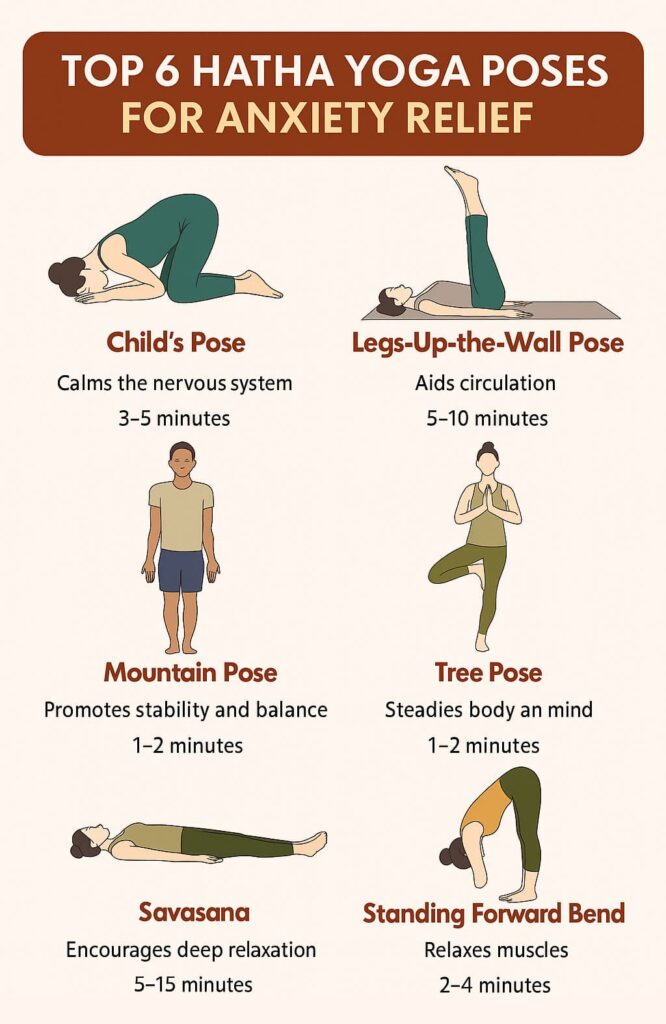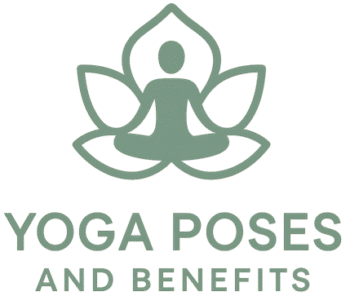How Hatha Yoga Helps Alleviate Anxiety
The Science Behind Anxiety and the Nervous System
Hatha yoga for anxiety has been increasingly studied in both clinical and wellness settings as a non-pharmaceutical intervention for mental health. According to several studies, hatha yoga positively affects the parasympathetic nervous system, which reduces anxiety, stress, and even symptoms of depression. Slow, diaphragmatic breathing paired with static poses stimulates the vagus nerve, balances cortisol levels, and promotes a sense of safety.
In hatha yoga, breath-centered movements allow the mind and body to reconnect. This helps regulate physiological reactions associated with anxiety disorders such as increased heart rate and shallow breathing. When guided with awareness, yoga becomes both a physical and mental treatment.
What Makes Hatha Yoga Effective for Mental Calm
Unlike faster-paced yoga styles like Vinyasa, hatha yoga slows the nervous system by emphasizing intentional breath, steady poses, and internal observation. This approach increases GABA (gamma-aminobutyric acid) levels—an inhibitory neurotransmitter associated with reduced anxiety—and strengthens areas of the brain associated with emotional regulation.
| Hatha Yoga | Vinyasa | Yin Yoga | Power Yoga | |
|---|---|---|---|---|
| Pace | Slow | Fast | Very slow | Intense |
| Breath Emphasis | High | Medium | High | Low |
| Anxiety Suitability | Excellent | Moderate | Excellent | Poor |
From a treatment perspective, hatha yoga offers students a view of themselves not just through effort, but through balance. Gentle actions and passive holds mesh physical alignment with emotional relief, creating a holistic mind-body practice. It is widely accessible and well-supported by evidence from sources such as Google Scholar and PubMed.
Poses in Hatha Yoga That Support Anxiety Reduction
Restorative Hatha Poses to Calm the Mind
Restorative yoga poses are central to hatha yoga for anxiety. They support the nervous system by encouraging stillness and deep abdominal breathing:
- Child’s Pose (Balasana) – Calms the mind and soothes the spine
- Legs-Up-the-Wall (Viparita Karani) – Aids circulation and relieves fatigue
- Supine Bound Angle Pose (Supta Baddha Konasana) – Releases tension in the hips and calms internal organs
Each pose is held for several minutes, supported by props, allowing the muscles to relax and the mind to reset.

Gentle Standing Poses That Ground the Body
Standing poses in hatha yoga help regulate anxiety by focusing attention on stability and somatic sensation:
- Mountain Pose (Tadasana) – Aligns the body and steadies the breath
- Tree Pose (Vrikshasana) – Promotes balance, concentration, and calm
- Standing Forward Fold (Uttanasana) – Stimulates the parasympathetic system through inverted posture
These poses bring awareness to the legs, feet, and spine, helping students actively shift from mental overwhelm to grounded presence.
How to Mesh Breath, Pose, and Awareness in Practice
Coordinating Breath with Physical Actions
One of the key effects of hatha yoga for anxiety is the synchronization of breath and movement. When practitioners inhale to lift or open and exhale to fold or release, the brain receives consistent signals of calm.
This mindful approach integrates body awareness with breath regulation. Each action—each pose—reinforces the feeling of being both mentally focused and physically safe. This is a critical step for anyone using yoga as a treatment for anxiety and stress disorders.
Mindfulness in Motion: Hatha as a Meditative Tool
Hatha yoga bridges movement and meditation. The repetitive, slow sequencing of hatha yoga poses encourages sustained attention and discourages mind wandering—common in anxious states. Studies show that this style of focused movement reduces activity in the amygdala, the brain’s emotional threat center.
Practicing hatha yoga with this meditative view turns postures into intentional actions that mesh awareness, stillness, and regulation.
Why Hatha Yoga Offers a Gentle Path to Anxiety Relief
A Holistic Practice That Supports Emotional Well-Being
Hatha yoga for anxiety is not just about poses. It is a practice in breath, attention, and intention. By incorporating passive poses, mindful actions, and a focus on abdominal breathing, practitioners engage both body and mind in a healing dialogue.
When you combine inhale and exhale with movement, when each pose becomes a view inward, yoga becomes more than exercise—it becomes therapy. The mesh of mental and physical action helps students find sustainable relief from anxiety and opens the door to clarity, presence, and resilience.
For those searching for a treatment that integrates science with tradition, hatha yoga offers a grounded, evidence-based path to wellness.
Building a Personal Hatha Yoga Practice for Anxiety Relief
Daily Actions That Reinforce Calm
Establishing a daily yoga practice supports neuroplasticity and mental resilience. These actions create structure and predictability, which are essential for those dealing with anxiety:
- Practice at the same time daily to train the nervous system
- Use consistent poses and breath cues to condition relaxation
- Choose soft lighting and reduce sensory distractions to enhance focus
These actions not only support anxiety relief but also empower long-term mental and emotional balance.
Combining Hatha Yoga with Other Anxiety Tools
Hatha yoga works synergistically with other interventions like:
- Meditation and breathwork for stress management
- Talk therapy or CBT for cognitive restructuring
- Creative arts, journaling, or somatic therapies to externalize emotions
According to multiple research articles available on PubMed (PMID/DOI linked studies), these complementary approaches significantly enhance the treatment effect of hatha yoga for anxiety.
Studies that Support the Use of Yoga for Anxiety Relief
Yoga has become a powerful tool for easing anxiety, offering a gentle, mind-body approach to emotional balance. In fact, recent research continues to affirm what many practitioners already feel—yoga doesn’t just stretch the body, it soothes the nervous system. A 10-week yoga program involving over 200 participants found significant decreases in anxiety, depression, and stress. Even more encouraging, participants also reported improved sleep and emotional well-being, making yoga a comprehensive wellness practice for mental health.
Technology is also expanding yoga’s reach. In a 2025 study, researchers explored a virtual reality-enhanced mindfulness and yoga program for new mothers facing anxiety and depression. The results were impressive: women using the VR-based intervention saw a 35% greater reduction in anxiety scores (measured by the GAD-7 scale) compared to traditional treatments. It’s a reminder that even when life feels hectic or overwhelming, there are accessible ways to find calm.
Science is also revealing how yoga works on a neurological level. A feature by the BBC explored how yoga increases gamma-aminobutyric acid (GABA) in the brain—a neurotransmitter known for its calming effects. Higher GABA levels are linked with reduced anxiety, better sleep, and greater emotional resilience.
College students, a group often overwhelmed with academic and social pressures, are also seeing measurable benefits. At Eastern Connecticut State University, researchers found that yoga significantly reduced anxiety and stress among students who participated in campus yoga classes. This adds to a growing body of evidence showing yoga’s potential to support mental wellness across age groups and life stages.
Common Questions about Yoga for Anxiety
The best hatha yoga poses for anxiety relief are those that calm the nervous system and promote grounding. Poses such as Child’s Pose, Legs-Up-the-Wall, and Supine Bound Angle Pose support deep abdominal breathing and help release tension in the body. Gentle standing poses like Mountain Pose and Tree Pose create stability and focus. These yoga poses activate the parasympathetic response, helping regulate stress and anxiety symptoms. Practicing these hatha yoga postures regularly builds emotional resilience and encourages mental calm.
Yes, multiple scientific studies have shown that hatha yoga supports mental health by reducing anxiety, depression, and chronic stress. Research published on platforms like PubMed and NCBI highlights yoga’s effect on the autonomic nervous system, cortisol regulation, and GABA (gamma-aminobutyric acid) levels. Hatha yoga interventions have demonstrated improvements in emotional regulation and reductions in anxiety-related disorders. This style’s slow, meditative pace and integration of breathwork make it ideal for long-term mental wellness.
Breathwork plays a central role in managing anxiety through hatha yoga. Slow, controlled breathing activates the vagus nerve, stabilizing the heart rate and calming the nervous system. Inhale-exhale coordination during poses helps reduce mental agitation and brings awareness into the body. Practicing breath-focused hatha yoga routines builds emotional control and reduces physiological symptoms of anxiety such as shallow breathing, restlessness, and elevated cortisol levels. Breath becomes the bridge between body, awareness, and calm.
Abdominal breathing—a cornerstone of hatha yoga—helps regulate the nervous system and reduce anxiety by activating the parasympathetic response. When you inhale deeply into the stomach and extend the exhale, you send calming signals to the brain and relax muscular tension. This form of breathing improves oxygen-carbon dioxide balance and engages the diaphragm, leading to greater internal stability. Hatha yoga integrates this technique into every pose, making it a foundational method for stress relief and emotional balance.
Hatha yoga differs from faster-paced yoga styles by focusing on slow, deliberate poses, breathwork, and internal awareness. While styles like Vinyasa or Power Yoga emphasize continuous movement, hatha yoga encourages longer holds, meditative transitions, and conscious abdominal breathing. This makes hatha more effective for treating anxiety, as it offers space for emotional processing and nervous system regulation. It’s particularly well-suited for beginners or those using yoga as a therapeutic intervention alongside clinical treatments.

